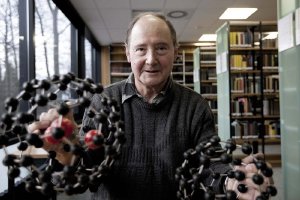Wolfgang Krätschmer has been awarded the European Inventor Award 2010 in the category of "lifetime achievement" for the development of the synthesis of fullerenes like C60, the soccer-ball molecule (European Patent Document EP 0500914B1 (1991/98)). In the presence of the Spanish Crown Prince couple the Award jury announced their decision during the European Inventor Award ceremony on 28 April in Madrid. Three inventor teams in each of the four categories had been nominated and were introduced in video interviews.
The fullerene synthesis was successfully accomplished by Wolfgang Krätschmer in 1990 at the MPI for Nuclear Physics together with D. R. Huffman and co-workers applying an astonishingly simple method: The soot which forms in an electric arc between graphite electrodes under inert gas in a cooled flask contains C60, minor amounts of C70 and traces of higher fullerenes. In addition nanotubes are formed. After extraction with a suitable solvent and chromatographic separation one obtains C60 crystals ("fullerite"), a new modification of elementary carbon. Thus, enough substance became available for its physical and chemical characterization, and it could be shown that the soccer-ball structure supposed by the later Nobel Prize winners H. W. Kroto, R. F. Curl and R. E. Smalley for the C60 molecule, which they had detected mass-spectrometrically, was indeed correct. Afterwards, Krätschmer's group also prepared a number of derivatives of C60, di- und polymers as well as endohedral noble-gas and metal fullerene compounds which they investigated spectroscopically.
 Wolfgang Krätschmer and his soccer-ball molecules (fullerenes).
Wolfgang Krätschmer and his soccer-ball molecules (fullerenes).
Wolfgang Krätschmer pursued his physics studies in Berlin and earned his PhD degree at the University of Heidelberg in 1971 with a thesis written at MPIK with the title "die anätzbaren Spuren künstlich beschleunigter schwerer Ionen in Quarzglas". Since that time he has been a senior scientist at MPIK with intermittent research periods from 1977/78 in the group of Donald R. Huffman at the University of Arizona and in the group of Roger F. Knacke at State University of New York/Stony Brook. In 1993 he was also bestowed the title of Honorary Professor by the University of Heidelberg.
In the beginning his research focused on the composition of cosmic rays and he collaborated in the investigation of lunar rock samples and meteorites. During the mid-seventies Wolfgang Krätschmer initiated spectroscopic investigations of substances like silicates, carbon dust and water-methane-ice, in order to explain observed but hitherto unidentified infrared absorptions of cosmic dust. Until this day his research area covers the infrared spectra of small carbon molecules of up to 21 carbon atoms and their oxides, which are stable only at very low temperatures in noble-gas matrices. Moreover, he participated in the development of a spectral photometer for the IR space telescope ISO of ESA.
Wolfgang Krätschmer has been awarded numerous prizes among them an Honorary Doctorate of the University of Basel in 2008.
The European Inventor Award, launched by the European Patent Office and the European Commission in 2006, is awarded annually in the four categories Industry, Small and Medium Enterprises, Non-European countries and Lifetime achievement. It is Europe's highest distinction for inventors and the winners are presented with a trophy in the shape of a sail, each year made of a different innovative material. This year's trophy is made of a type of fibreglass concrete. The European Inventor Award jury is made up of seven leading experts from business, science, technology and industry. The award ceremony takes place in the country which holds the EU Council Presidency.